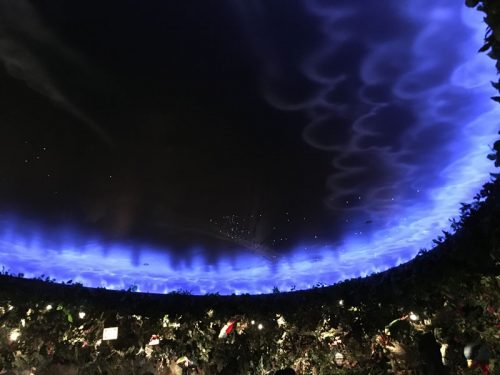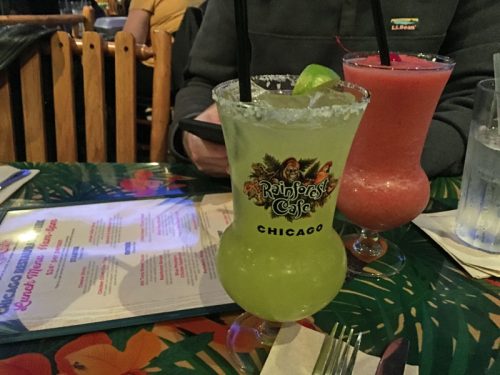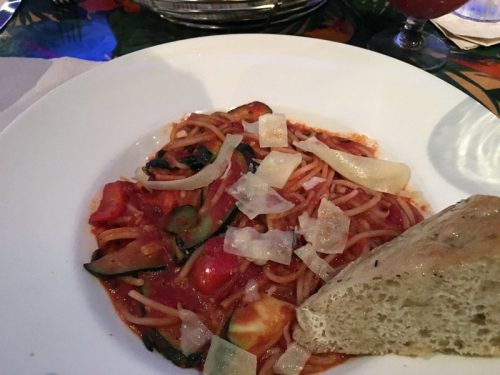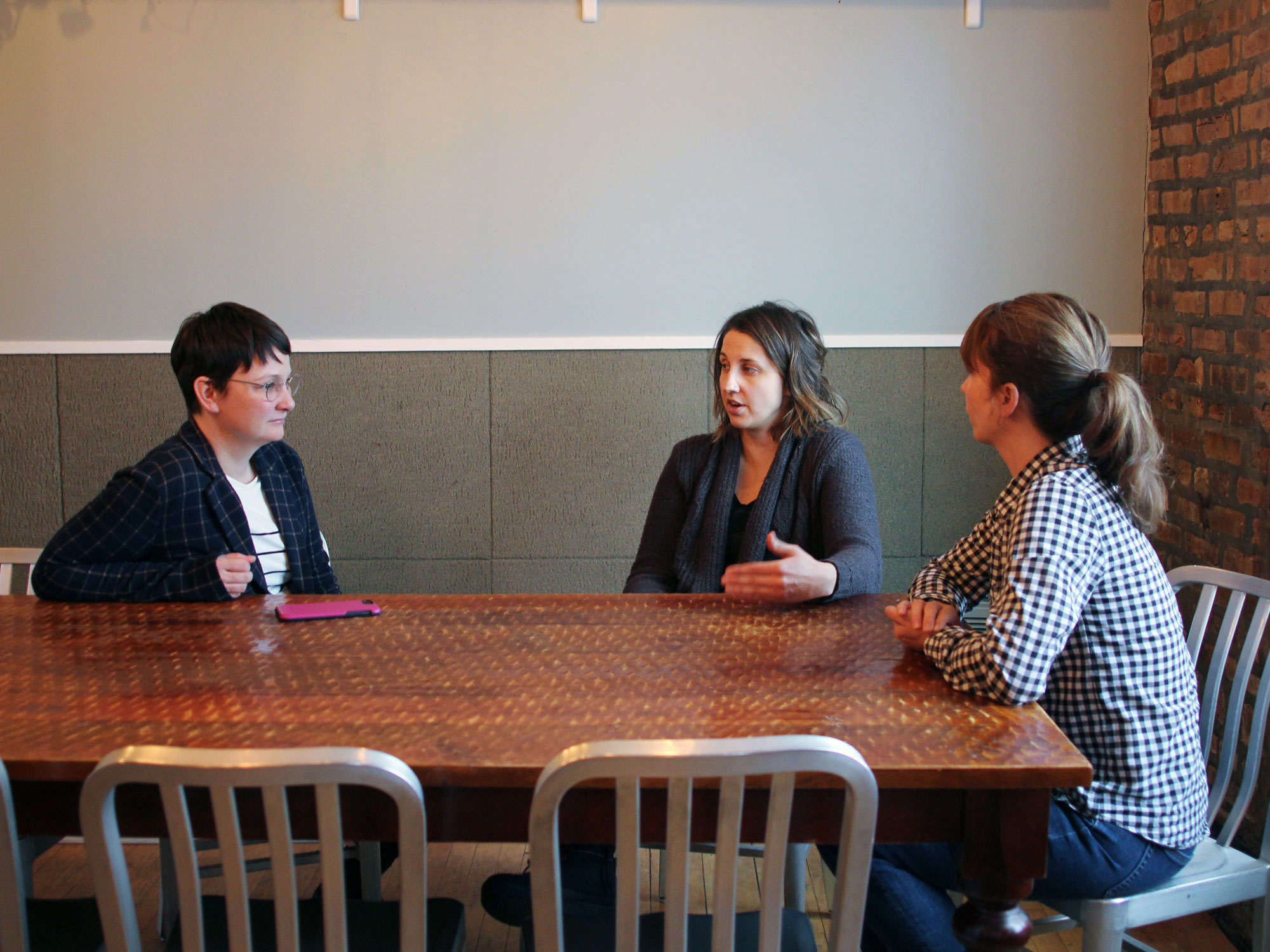“I’M SORRY,” THE HOSTESS TELLS US, “but we don’t have a bar at the Rainforest Cafe.”
We’re less than 10 minutes into our 30 minute wait here, and we’re surrounded by children. Some are playing tag. Others are rifling through the cheap kitsch of the gift shop, which doubles as the front of house. A gallery of jungle animals looks down on us, as if to ask, Are you SURE you’re supposed to be here?
I need a drink. I’m tempted to bolt, to take refuge in any one of River North’s fine restaurants—anything to get out of the inexplicably humid Rainforest Cafe gift shop, anything to be around people my age, anything to avoid the meal that awaits us. But I don’t: I’m here, after all, on a mission: To subject myself to the Rainforest Cafe’s Chicago Restaurant Week menu, for your edification.
Did you not know the Rainforest Cafe had a Restaurant Week menu? I didn’t either until recently, when Eater Chicago listed it among the worst deals of the city’s annual culinary showcase. The WORST deal? I thought. How is it that the Rainforest Cafe, corny theme restaurant of my 90s youth, has ANY deal for Restaurant Week?
Questions gnawed at me for days: Whose idea was this? Who was this for? Do people still go there? It all seemed so strange, its juxtaposition among some of the finest restaurants in this city so incongruous, that I resolved to experience it for myself.
I DO NOT HAVE A CHILD WITH ME for this excursion, but I do have my friend Colin, who days earlier had dined at the excellent Bellemore and was therefore in an excellent position to gauge the contrast between what is perhaps one of the best Restaurant Week deals in the city and one of the worst. He’s proven himself game for similar journalistic stunts in the past, including an utterly unsuccessful audition for MTV’s the Real World a few years back, and I knew I could count on him for another potentially embarrassing undertaking, this time of the gastronomic variety.
But after some time waiting in the inexplicably humid gift shop, conspicuously out of place among all these antsy children, without even so much as a drink to make it all tolerable, I begin to feel a little bad. Asking a buddy to try out for a reality show is one thing—this, I begin to fear, would stretch the limits of my friend’s loyalty. But then, just as I make my fifth pass by the display of dishware with cartoon animals on them, a voice comes over the loudspeaker:
“Eric, safari of two,” our hostess says. “Your adventure is about to begin.”
THE RAINFOREST CAFE FIRST OPENED IN 1994, as part of the theme restaurant boom of the ‘90s that gave us Planet Hollywood and saw the expansion of existing eatertainment giants like Hard Rock Cafe and Medieval Times. The brainchild of developer Steven Schussler, the first Rainforest Cafe opened at the Mall of America just outside Minneapolis—and, indeed, the suburban shopping mall is perhaps its most natural habitat.
With its plastic fauna and plastic animals, it was both of and apart from the rest of the mall. Mall restaurants always have the feel of a last resort, the places you go because you’re already there, but the Rainforest Cafe, at least to a kid, had the feeling of an occasion. It was someplace you chose to go rather than merely ended up at. Or so it seemed to me, a millennial whose west suburban youth coincided with the theme restaurant boom and whose childhood fantasies of exploring faraway lands and living a life of adventure could be temporarily appeased within the tropical confines of the chain.
We’re not the only child-free adults in the room. Seated a few tables away from us is a group of tourists, whose impression of America must surely be warped horrifically by this place.
But something happened as the decade wore on. The eatertainment bubble burst, and the theme restaurant fad began to fade. “Though the restaurants’ themes ranged from movie or TV memories to sports stars, supermodels and tropical rain forests, the food was often dismissed as terrible,” the New York Times reported in 1998. “The elaborate decor—rock-and-roll collectibles, racing cars, animatronic jungle habitats—was impressive but distracting, and the novelty soon wore thin.”
At least it did for me—I was getting older and my interests were changing, and suddenly talking trees and animatronic wildlife seemed silly to me, kid stuff. We no longer pestered our parents to take us to the Rainforest Cafe, or to Mars 2112—the Rainforest Cafe, but for outer space. And our parents were only too glad to oblige.
 Eric Lutz
Eric Lutz TWENTY YEARS LATER, I am being told by our hostess to follow the green frog footprints up the stairs to a second host area. These prints were likely made by Cha! Cha!, the disquieting tree frog that serves as the chain’s mascot and who sits perched atop the restaurant’s Chicago location at the corner of Clark and Ontario—in the shadow of the Hard Rock Cafe’s towering guitar, and across from the former Rock ‘n’ Roll McDonald’s. We track frog-prints up the stairs and past a small pond, where a statue of Atlas squats a globe. Rescue the Rainforest, reads an inscription on the globe’s equator—a cheerful pre-dinner reminder that deforestation is threatening to erase one of the world’s most vibrant and important ecosystems.
“We’re here for the adventure,” I say, as we approach our second of two hostesses.
“Any kids?” she replies.
“No,” I say, expecting her to rain judgement upon me. But the Rainforest Cafe, as I will learn over the course of my meal, is a judgement-free zone—a place whose populace is not only not inclined to mock others for their atrocious taste in food, but who are in no position to do, as they, too, have chosen to come here. There is a kind of camaraderie, then, that develops between both the diners and the staff—a bond built on nobody being exactly sure this is where they want to be. How did I get here?
The place is much smaller than I had expected, even though it’s half-empty, raising questions about why we were made to wait. When we’d arrived, our first hostess had asked us if we had a reservation. We hadn’t thought we’d needed one. “It’s less of an adventure if you call ahead,” Colin reasoned. But she’d told us that without one, we’d need to wait half an hour—and, indeed, our wait lasted precisely 30 minutes, not a second more, not a second less, which now seems to us purposeful, a gambit to keep us in the souvenir shop to increase the likelihood we’d buy a plastic slug or a tee-shirt with the “Dalai Llama” on it or something.
The clientele, as expected, is mostly families with young children, though I am surprised to report that my buddy and I are not the only child-free adults in the room. Seated a few tables away from us is a group of tourists, whose impression of America must surely be warped horrifically by this place. To the right of them are two young women, one of whom is wearing a tee-shirt indicating that she was part of her college’s 2015 graduating class. Behind us, there is a couple of indeterminate age and a large table full of high school students, which seems about right. Above our heads, there’s a fake purple sky—a kind of trippy, ethereal take on nighttime that resembles an old Windows screensaver.
That gives way to all manner of pseudo-fauna—large leaves and veiny branches, out of which poke the heads of creatures that may or may not actually make their homes in real rainforests. Our menus fit right in with the aesthetics around us: brightly-colored, cheaply-laminated tack—a Tiki bar menu as imagined by Guy Fieri. We each have at least three different menus: a regular menu, on which you can find everything from poke to pasta to pulled pork; a specials menu; and the Chicago Restaurant Week menu, the one we were here to sample. Our adventure, if you will.
 Eric Lutz
Eric Lutz THE CHICAGO RESTAURANT WEEK MENU does not inspire much confidence. The deal, it informs us, will cost us each $24. For that price, we are permitted to select one of four possible starters; one of eight entrees; and one of two dessert options.
That rate might qualify as a good deal if any of the menu items sounded reasonably appetizing, but sadly, they do not. On the starters menu, we have cheese sticks, “chicken chimi-cha-chas,” spinach and artichoke dip, and something called “jungle safari soup.” Entrees include some safe-sounding choices, like the “Rainforest Burger” and a non-threatening chicken sandwich, but also some more potentially perilous fare, such as the “anaconda pasta,” which conjures up, not to the delight I would have had at age 8, snakes slithering in a big bowl of marinara. Thankfully, Rainforest Cafe is far less ambitious with their small but straightforward dessert menu: if we survive our apps and entrees, we’ll be rewarded with either key lime pie or an ice cream sundae.
Colin and I look at each other, completely out of our depth. Neither of us is quite sure what will be palatable, nor are we sure which of the Rainforest Cafe’s neon-colored cocktails would be best to force it all down. Fortunately, our waitress arrives eager to help. She’s a stunningly kind woman, tall and thin and probably in her late 60s. She carries herself in the manner of the waitress at your favorite diner in your hometown, except instead of greasy booths, her habitat is the tropical rainforest.
“Welcome to the Rainforest Cafe,” she says with more enthusiasm than I have toward literally anything. “Have you dined with us before?”
“Been a while,” Colin says.
“Well, welcome back,” she says, and launches into a quick refresher as to “how things work” there. The family of gorillas, she says, gesturing to the animatronic apes watching over the dining room from a perch nearby, come to life “every 15 minutes or so.” Indoor storms come with roughly the same frequency. “You’ll get thunder and lightning and rain,” she says, “but you won’t get wet.”
She has good things to say in support of the Fusion Margarita, a regular margarita but with vodka in it, and I order myself one based on the strength of her recommendation. But Colin, rebel that he is, goes a different route, opting instead for a Strawberry Island Daiquiri. She leaves to fetch our drinks, and returns with two effulgent, $15 drinks in souvenir glasses we’ll get to take home with us, each sporting the Rainforest Cafe logo on it, along with its slogan: A Wild Place To Shop and Eat.
After taking my first sip, my thought was that my drink had too much sugar. After taking my second sip, my thought was that my drink had way too much sugar. It tasted like a margarita in the sense that it there was lime and alcohol in it, but what it more closely resembled was a gas station slushie, or perhaps some melted snow from the curb of Clark Street that they’d poured a bottle of Mountain Dew over. Still, it got the job done fine, and greased the wheels just enough to give me the confidence I needed to put in an order.
For my appetizer, I go with the chicken chimi-cha-chas, the Rainforest Cafe’s take on a chimichanga. Life’s short—why not? For my entree, I decided to go with the anaconda pasta — quinoa spaghetti with vegetables, shaved parmesan cheese, red pepper flakes, and white wine tomato sauce, which would sound promising had I not had to talk over a squealing animatronic chimp to order it. Colin took the safe route, ordering up some cheese sticks and a chicken sandwich—items that one would be hard-pressed to screw up. We think.
 Eric Lutz
Eric Lutz OUR APPS ARRIVE PROMPTLY—one might say a bit too promptly.
Colin’s cheese sticks look and taste like cheese sticks, but inspire some concern with their uneven temperature. Even more worrisome are my chimichangas, whose taste seems to foreshadow the digestive nightmare I’ll later endure. None of it is bad, necessarily, but it is certainly not Bellemore, where just days earlier Colin enjoyed some fine tartare.
“If Rainforest Cafe had tartare,” I say, “ would you try it?”
“I would not,” he replies. Nice guy that he is, though, he makes sure to add that he finds the food here “okay.” And indeed, it positively shrieks “okay” — if you’ve had lunch food at a high school cafeteria, you’ve had this. It is uninspired and of frozen-food quality, but certainly edible and not entirely objectionable.
That is, until the main courses arrive.
Colin’s decision to play it safe again pays off, with a chicken sandwich and fries that would not be out of place at your local watering hole. But the anaconda pasta—well, it’s really something to behold. The spaghetti is barely visible in what can only be described as a deep pool of marker-red tomato sauce. Large vegetable shards, cooked to varying degrees, bob like buoys in the bowl. Atop the whole thing, almost like an afterthought, are some thin sheets of parmesan cheese, which somewhat resemble Listerine strips. And the bread?
“Why is it so shiny?” Colin says of the glistening gray hunk of ciabatta balancing on the edge of the bowl. “You can see the reflection of the pasta in it.”
I wager that it is garlic flavoring and tear off a chunk, run it through the red sauce, and give it a try. To my alarm, there are no hints of garlic—no hints of any known flavor whatsoever — and the mystery of the bread’s sheen remains unsolved. When I take my first bite of the pasta, I find myself pitying it—it’s doing its best to uphold its end of the bargain, but can’t overcome the sheer volume of the sauce, which both looks like and tastes like Campbell’s tomato soup dumped on top of my noodles.
As we power through our meals, a storm starts: rolling thunder like the growl of a washing machine; a flickering of lights; rain sounds that seem sampled from a relaxation tape. We’d experienced one like this earlier, down in the gift shop, but it’s more impressive up here, where the rain and thunder sounds are louder and where it’s dim enough that the light-flickering is a better approximation of lightning in the night sky. But it’s still underwhelming, and makes it hard for me to imagine how it ever impressed me as a kid.
THAT’S WHAT GROWING OLDER DOES TO YOU, though. Things that once made sense no longer do, and things that didn’t make sense then make sense now. Why did your parents drag their feet as they brought you into Rainforest Cafe, or say “not today” when you wanted to go, and you were at the mall anyway, and come on, please, it’s right there?!
Ah, you say, sitting here in the remarkably humid Rainforest Cafe, trying to finish an overpriced plate of noodles and tomato goop so you can get to dessert, I see now.
This is the circle of life in the Rainforest Cafe: what starts out as a treat for you eventually becomes something you treat someone else to.
Perhaps I’ll find myself sitting here again not long from now, watching my own future child watch a fake rain storm with wonder. Maybe I’ll grumble as I wait for precisely 30 minutes among the plastic crap of the souvenir shop, ponder whatever the hell Mojo Bones are supposed to be, and swig from my neon drink. Maybe I’ll nudge the kid, say something dumb and obvious like, “It’s storming!” (Never too young to start rolling your eyes at your old man.)
And what will I think as I sit there—screensaver sky above me, frog-print floors below me? Will I scrutinize the fish tacos, uninspired and kind of sad? Will I glower as the animatronic apes start to squeak over each other for the fourth time that hour? Or will I look around the faux-bamboo table at my family, a safari of three or even four maybe, and think, Ah, yes. Our adventure has begun.
Latest
Join the Discussion
After you comment, click Post. If you're not already logged in you will be asked to log in or register with Disqus.







